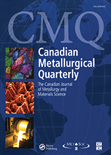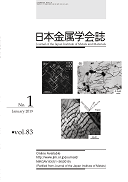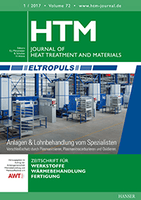
Metallurgical Research & Technology
Scope & Guideline
Elevating the standards of metallurgical research and engineering.
Introduction
Aims and Scopes
- Metallurgical Processes and Techniques:
Research on various metallurgical processes such as smelting, refining, casting, and welding, focusing on optimizing techniques and improving efficiency. - Material Properties and Characterization:
Studies that explore the mechanical, thermal, and chemical properties of metals and alloys, including the effects of different alloying elements and processing conditions. - Innovative Materials and Applications:
Exploration of new materials, including high-strength steels, composites, and advanced alloys, along with their applications in industries like automotive, aerospace, and energy. - Environmental and Sustainability Issues:
Research addressing the environmental impact of metallurgical processes, including waste recycling, energy consumption, and the development of sustainable practices. - Computational Modeling and Simulation:
Utilization of computational methods to model metallurgical processes and predict material behavior, aiding in the understanding and optimization of production techniques.
Trending and Emerging
- Additive Manufacturing and 3D Printing:
A growing number of publications are exploring additive manufacturing techniques, highlighting their potential for creating complex geometries and tailored material properties. - Machine Learning and Data-Driven Approaches:
There is a significant increase in the use of machine learning and data analytics to predict material behavior and optimize metallurgical processes, showcasing the integration of artificial intelligence in metallurgy. - Sustainability and Recycling:
Research focused on sustainable practices and the recycling of metallurgical by-products is gaining traction, reflecting the industry's response to environmental concerns and resource scarcity. - Advanced Coatings and Surface Treatments:
Emerging studies on advanced coatings and surface modification techniques are becoming more prevalent, aimed at enhancing material performance and durability. - Nanostructured Materials and Properties:
There is an increasing interest in nanostructured materials, with research exploring their unique properties and potential applications in various fields.
Declining or Waning
- Traditional Ferrous Metallurgy:
There has been a noticeable decrease in studies focused exclusively on traditional ferrous metallurgy, such as basic iron and steelmaking processes, as new materials and methods gain prominence. - Conventional Casting Techniques:
Research related to conventional casting methods, particularly those that do not incorporate advanced technologies or innovations, appears to be waning as the field shifts towards more modern techniques. - Low-Temperature Metallurgy:
Topics related to low-temperature metallurgical processes are being published less frequently, possibly due to the increased focus on high-performance materials and processes at elevated temperatures.
Similar Journals

Russian Journal of Non-Ferrous Metals
Exploring the Mechanics of Metals and AlloysThe Russian Journal of Non-Ferrous Metals, published by PLEIADES PUBLISHING INC, serves as a vital resource for researchers and professionals in the fields of materials science and engineering. With a dual ISSN (1067-8212 for print and 1934-970X for online), this journal has been instrumental in disseminating cutting-edge research from 2007 to 2023. Specializing in the mechanics of materials, metals and alloys, and the study of surfaces, coatings, and films, it provides invaluable insights into the latest advancements and applications in these areas. Although currently categorized in the Q4 tier for mechanics of materials and surfaces, and Q3 for metals and alloys in the 2023 rankings, its commitment to quality research is reflected in its Scopus metrics, ranking it within the competitive spectrum of its fields. While not an open access journal, it remains a crucial academic platform for fostering knowledge exchange among professionals and scholars. By publishing high-quality articles, the Russian Journal of Non-Ferrous Metals contributes significantly to the ongoing dialogue in metallurgical science and engineering.

CANADIAN METALLURGICAL QUARTERLY
Shaping Tomorrow's Metallurgical Innovations Today.Canadian Metallurgical Quarterly is a prestigious scholarly journal published by Taylor & Francis Ltd, dedicated to the field of metallurgical engineering and materials science. With a rich history dating back to its inception in 1962 and continuing through its most recent publications, this journal serves as a vital platform for the dissemination of innovative research, advancements, and critical reviews in metallurgy, metals, and alloys. Positioned strategically within the academic community, it holds a significant impact factor and is currently rated in the Q2 category for Metals and Alloys, and Q3 in Industrial and Manufacturing Engineering as of 2023, showcasing its authoritative role in these disciplines. Although it does not offer open access, the journal remains widely recognized for its rigorous peer-review process, ensuring that published work adheres to the highest standards of scientific quality. Researchers, professionals, and students alike will find invaluable insights and contributions that drive the field forward.

Journal of the Japan Institute of Metals and Materials
Illuminating the future of materials science and engineering.Journal of the Japan Institute of Metals and Materials (ISSN: 0021-4876, E-ISSN: 1880-6880) serves as a vital academic platform under the esteemed auspices of the Japan Institute of Metals & Materials. This journal, with a rich publication history dating back to 1937, focuses on advancing knowledge in the fields of metallurgy, materials science, and engineering, making it an important resource for researchers, professionals, and students alike. Although the journal has been categorized in Q4 quartiles across several subject areas, including Condensed Matter Physics and Materials Chemistry, it plays a critical role in disseminating essential findings and fostering discussion regarding innovations in metal and materials research. Notably, the journal operates without open access, which encourages targeted readership engagement through its curated content. Based in Japan, it continues to contribute significantly to the academic community by bridging the gap between scientific inquiry and practical application in materials technology.

HTM-Journal of Heat Treatment and Materials
Advancing the frontiers of heat treatment and materials science.HTM-Journal of Heat Treatment and Materials, published by WALTER DE GRUYTER GMBH, serves as a vital platform for the dissemination of research in the fields of Industrial and Manufacturing Engineering, Materials Chemistry, and Metals and Alloys. With an ISSN of 1867-2493 and an E-ISSN of 2194-1831, this peer-reviewed journal focuses on the advancements and methodologies associated with heat treatment processes, materials innovation, and their applications across various industries. Notably recognized in the Q3 category for Industrial and Manufacturing Engineering and Materials Chemistry, as well as Q2 for Metals and Alloys, the journal has garnered significant attention, illustrated by its Scopus rankings, placing it among the scholarly discussions within the field. Although it operates under a closed access model, the journal remains committed to impactful research that influences both academia and industry, ensuring its relevance and importance in shaping future developments in materials science. It is an essential resource for researchers, professionals, and students striving to stay at the forefront of heat treatment and materials research.

RUSSIAN METALLURGY
Illuminating the Path of Metallurgical ExcellenceRUSSIAN METALLURGY is a distinguished journal published by PLEIADES PUBLISHING INC, focusing on the fields of metals and alloys. With an ISSN of 0036-0295 and an E-ISSN of 1555-6255, this journal serves as a vital resource for researchers and practitioners alike, offering insights into the latest advancements and innovative research within the metallurgy domain. Recognized in a competitive landscape, it holds a Q3 ranking in the Metals and Alloys category as of 2023, reflecting its commitment to rigorous scientific dissemination. The journal spans a significant historical timeline of research since its inception in 1984, with aims to advance the knowledge and application of metallurgical science. Although currently not open access, it remains crucial for those aiming to stay current in the dynamic field of materials science. RUSSIAN METALLURGY fosters a deeper understanding of the physical and chemical properties of metals, guiding future innovations in industry and academia.

INTERNATIONAL MATERIALS REVIEWS
Elevating Standards in Materials ResearchINTERNATIONAL MATERIALS REVIEWS, published by SAGE Publications Inc, is a leading journal dedicated to the comprehensive analysis of contemporary research in the fields of materials chemistry, mechanical engineering, mechanics of materials, and the study of metals and alloys. With an impressive impact factor and a Q1 ranking across multiple categories such as Materials Chemistry and Mechanical Engineering in 2023, it ranks amongst the top journals for innovative materials research. The journal has a long-standing history since its inception in 1987 and continues to serve as a crucial resource for academics and professionals alike. Although it is not open access, it is renowned for its rigorous peer-review process and its commitment to disseminating high-quality materials science research globally. Researchers, students, and industry professionals benefit greatly from the journal's insightful reviews, both for the advancement of theoretical knowledge and practical applications within the fast-evolving materials field.

Acta Metallurgica Slovaca
Exploring the forefront of metallurgical research and collaboration.Acta Metallurgica Slovaca is a distinguished open-access journal published by SCICELL SRO that has been pivotal in the field of Materials Science and Metallurgy since its inception. With a robust commitment to disseminating high-quality research, this journal covers a wide array of topics within the scope of metals and alloys. Now indexed in Scopus, it ranks 82nd out of 176 in its category, reflecting a growing influence within the scientific community. With a quartile ranking of Q3 as of 2023, Acta Metallurgica Slovaca serves as an essential platform for researchers and professionals seeking to share innovative findings and developments in metallurgical science. Open access since 2013, it ensures that research is accessible to all, fostering collaboration and engagement across academia and industry worldwide. With a converged publication timeline extending from 2009 to 2024, this journal continues to play a crucial role in advancing knowledge and addressing contemporary challenges in the metallurgy sector.

TETSU TO HAGANE-JOURNAL OF THE IRON AND STEEL INSTITUTE OF JAPAN
Connecting Researchers through Open Access InsightsTETSU TO HAGANE - JOURNAL OF THE IRON AND STEEL INSTITUTE OF JAPAN is a prominent journal that publishes cutting-edge research in the fields of metallurgy, materials science, and condensed matter physics. Since its inception, this esteemed publication has served as a vital resource for professionals and researchers interested in the advancements in iron and steel technology. Published by the Iron Steel Institute of Japan, this journal has embraced an Open Access model since 2020, facilitating broad dissemination of knowledge to a global audience. The journal showcases significant contributions to materials chemistry and alloys, while consistently ranking in the Q3 and Q4 quartiles across various fields, reflecting its commitment to maintaining rigorous academic standards. Located in the heart of Tokyo, this journal not only highlights research developments in Japan but also fosters international collaboration, making it an indispensable asset for anyone engaged in the study and application of iron and steel.

METALLURGICAL AND MATERIALS TRANSACTIONS A-PHYSICAL METALLURGY AND MATERIALS SCIENCE
Transforming Research into Impactful KnowledgeMETALLURGICAL AND MATERIALS TRANSACTIONS A - PHYSICAL METALLURGY AND MATERIALS SCIENCE, published by Springer, is a prestigious journal that plays a pivotal role in advancing the fields of physical metallurgy and materials science. With an ISSN of 1073-5623 and an E-ISSN of 1543-1940, this American journal provides a vital platform for disseminating cutting-edge research and innovative findings relevant to condensed matter physics, mechanics of materials, and metals and alloys. The journal, indexed with an impressive Q1 ranking in multiple categories in 2023, ensures its position among the top-tier publications, making it an essential resource for researchers, professionals, and students alike. Spanning decades of invaluable contributions since its inception in 1975, METALLURGICAL AND MATERIALS TRANSACTIONS A focuses on fostering academic dialogue, promoting collaboration, and showcasing leading-edge discoveries that drive the materials science community forward. Researchers seeking to publish their work in a highly visible forum will find this journal an optimal choice for reaching a discerning audience.

CIS Iron and Steel Review
Unveiling Trends in the Iron and Steel IndustryCIS Iron and Steel Review is a prestigious academic journal published by ORE & METALS PUBLISHERS, specializing in the fields of Industrial and Manufacturing Engineering and Metals and Alloys. With a strong commitment to advancing knowledge in these critical areas, the journal has achieved a significant position, evidenced by its Q2 category rankings in both fields for 2023 and an impressive Scopus ranking alongside a substantial global readership. Operating from the heart of the Russian Federation, it provides a platform for researchers, professionals, and students to share innovative breakthroughs, explore trends, and discuss challenges within the iron and steel industry. The journal supports open access formats, enabling wider accessibility and dissemination of research findings, thereby fostering collaboration and engagement within the scientific community. With its converged years spanning from 2014 to 2024, the CIS Iron and Steel Review remains pivotal in enhancing the understanding of materials science and engineering practices in an ever-evolving industrial landscape.